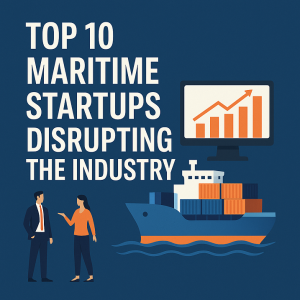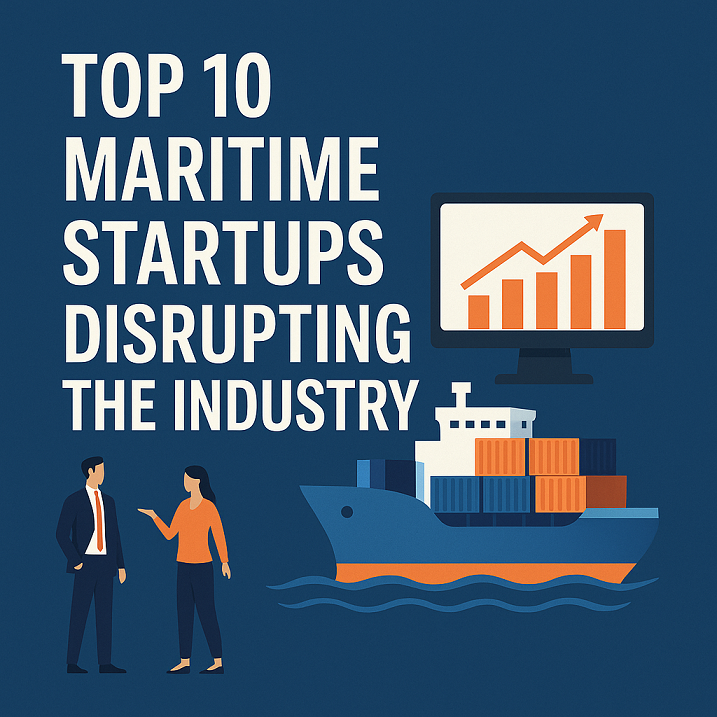Discover the top 10 maritime startups disrupting the shipping industry. Learn how these innovators are revolutionizing smart shipping, sustainability, and logistics with AI, automation, and digital solutions.
Why Maritime Innovation Matters in Today’s Global Trade Environment
Shipping is at a crossroads. As regulatory pressure increases and global supply chains grow more complex, the maritime industry is under immense pressure to modernize. For decades, the sector relied on traditional methods, but today, startups are injecting new energy, leveraging technologies like artificial intelligence, IoT, blockchain, alternative fuels, and robotics.
From port automation and autonomous vessels to carbon tracking and digital freight platforms, maritime startups are breaking new ground. These agile disruptors are not just supplementing legacy systems—they are rebuilding the maritime infrastructure from the code up.
According to the International Chamber of Shipping (ICS) and IMO, digitalization and decarbonization will dominate the maritime agenda through 2050. Startups are emerging as the catalysts for transformation, accelerating progress across fleet operations, emissions compliance, crew management, and cargo logistics.
In this article, we explore the top 10 maritime startups that are making waves—and examine why they matter.

1. ZeroNorth (Denmark) – Voyage Optimization for Emissions Reduction
ZeroNorth helps shipowners cut fuel consumption and CO₂ emissions through data-driven voyage optimization. Originally spun off from Maersk Tankers, the startup is now a leading SaaS platform in decarbonized logistics.
Features:
-
Real-time speed and routing optimization
-
Emissions analytics for CII compliance
-
Commercial performance benchmarking
Results: Operators report fuel savings of 5–15%, contributing to compliance with IMO’s GHG reduction goals.
Website: https://zeronorth.com
2. Spire Maritime (USA) – Satellite-Powered Vessel Intelligence
Spire uses a constellation of low-Earth orbit nanosatellites to collect global AIS data and provide predictive analytics for shipping routes, ETAs, and vessel tracking.
Benefits:
-
Enhanced visibility in congested regions
-
Predictive port congestion alerts
-
Supply chain optimization
Adoption: Supply chain operators use Spire to track illegal fishing, optimize bunker planning, and analyze global fleet trends.
Website: https://www.spire.com/maritime
3. Maqsam (UAE) – Voice AI for Maritime Communications
Maqsam develops AI-powered voice tools designed to improve safety, crew operations, and compliance onboard ships.
Applications:
-
Automated distress response and logging
-
Crew training and translation tools
-
Encrypted shore-to-ship communications
Why It Matters: As smart bridges and reduced crew become more common, voice-controlled systems will enhance efficiency and safety.
Website: https://www.maqsam.com
4. Shone (France/USA) – Autonomous Retrofit for Existing Ships
Instead of building new autonomous vessels from scratch, Shone retrofits existing ships with autonomous capabilities using:
-
AI software layers
-
Radar integration
-
Remote command interfaces
Project Highlight: Shone has partnered with CMA CGM to develop semi-autonomous capabilities on commercial cargo ships.
Website: https://www.shone.co
5. PortXchange (Netherlands) – Port Call Optimization
A spinoff from the Port of Rotterdam, PortXchange synchronizes all stakeholders—pilots, terminals, shipping lines—for smarter, greener port calls.
Features:
-
Real-time berth scheduling
-
Predictive ETA and ETD planning
-
Reduced anchor time and emissions
Impact: Ships using PortXchange tools cut idle anchorage by up to 20%, reducing fuel costs and port congestion.
Website: https://www.port-xchange.com
6. BunkerTrace (UK/Netherlands) – Fuel Authentication with Blockchain & DNA
BunkerTrace uses a two-layer system:
-
Synthetic DNA markers added to fuel at loading
-
Blockchain records to track custody and composition
Purpose: Prevent fuel fraud and ensure MARPOL compliance, especially under IMO 2020 sulfur regulations.
Real-World Test: Trials showed the ability to trace tampering or dilution, supporting fair pricing and environmental accountability.
Website: https://www.bunkertrace.com
7. Nautilus Labs (USA) – Predictive Fleet Performance
Nautilus Labs provides AI tools that combine onboard data with weather, market conditions, and performance history to:
-
Predict future fuel consumption
-
Enable data-driven chartering
-
Optimize engine settings and trim
Case Study: Eastern Pacific Shipping reduced emissions intensity by over 10% using Nautilus Labs’ insights.
Website: https://www.nautiluslabs.com
8. Seably (Sweden) – Digital Training Marketplace for Seafarers
Seably offers STCW-compliant online courses for maritime professionals, with real-time certification, company-specific modules, and gamified assessments.
Features:
-
Custom LMS for shipping companies
-
Self-paced and VR-enabled training
-
Regulatory tracking and analytics
Why It’s Disruptive: It democratizes access to quality training—whether you’re a cadet at sea or a company onboarding new crew.
Website: https://www.seably.com
9. Sedna (UK/USA) – Maritime Email Intelligence Platform
Sedna transforms traditional inboxes into actionable workspaces. It applies AI to categorize, prioritize, and automate communications related to:
-
Vessel operations
-
Chartering
-
Port clearances
Adoption: Maersk Tankers and Oldendorff use Sedna to reduce internal email volume by 40%+, freeing up time for critical decisions.
Website: https://www.sedna.com
10. Maritime Education – Digital Learning Platform for Maritime Industry
Maritime Education is a comprehensive digital platform dedicated to advancing maritime training and career development. It offers STCW-compliant courses, competency assessments, and customized learning solutions for seafarers and maritime companies worldwide.
Key Features
-
On-demand courses in safety, navigation, engineering, and compliance
-
Simulation-based learning for engine room operations and emergency procedures
-
Custom training programs tailored to fleet and company requirements
-
Career development resources to support seafarers’ professional growth
Use Case
A major tanker operator utilized Maritime Education’s platform to streamline crew certification renewals, reducing administrative tasks by 30% and achieving 100% compliance with IMO regulations.
🔗 Website: www.maritimeducation.com

FAQ: Maritime Startups and Innovation
Q1: Why are startups gaining traction in a traditionally slow-moving industry?
A: Rising pressure to meet IMO decarbonization targets, coupled with digitalization, is forcing shipowners and port operators to seek agile, innovative solutions.
Q2: Are startups working with regulators and legacy companies?
A: Yes. Many startups are part of pilot programs with IMO, DNV, class societies, and major carriers. Collaboration is critical for scaling.
Q3: Do these startups only target large fleet operators?
A: No. Many offer SaaS models that scale for smaller operators, ports, or even individual vessels—especially in training and analytics.
Q4: What’s the investment outlook for maritime tech?
A: Global maritime tech investment reached $3.8 billion in 2023, with sustained growth expected as decarbonization deadlines approach.
Q5: How can maritime students or cadets engage with these startups?
A: Many offer internships, online platforms, and academic partnerships. Staying updated via their websites or LinkedIn is a great start.
Conclusion
The maritime world is changing—fast. Startups are no longer fringe players; they are rewriting the rules of global shipping, one algorithm, dashboard, or drone at a time.
These top 10 maritime startups are solving long-standing challenges in efficiency, compliance, safety, and crew empowerment. For shipping companies, investors, and professionals, the message is clear: embracing innovation is not just about staying ahead—it’s about staying afloat.
References
-
International Chamber of Shipping. (2023). Digitalization and Decarbonization Strategy Overview. https://www.ics-shipping.org
-
World Maritime University. (2022). Innovation in Maritime Technology and Education. https://www.wmu.se
-
DNV. (2023). Maritime Forecast to 2050. https://www.dnv.com
-
Startup Portfolios. (2023). ZeroNorth, Seably, and Orca AI Case Studies. https://www.startupmaritime.com

